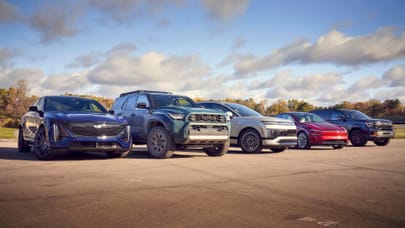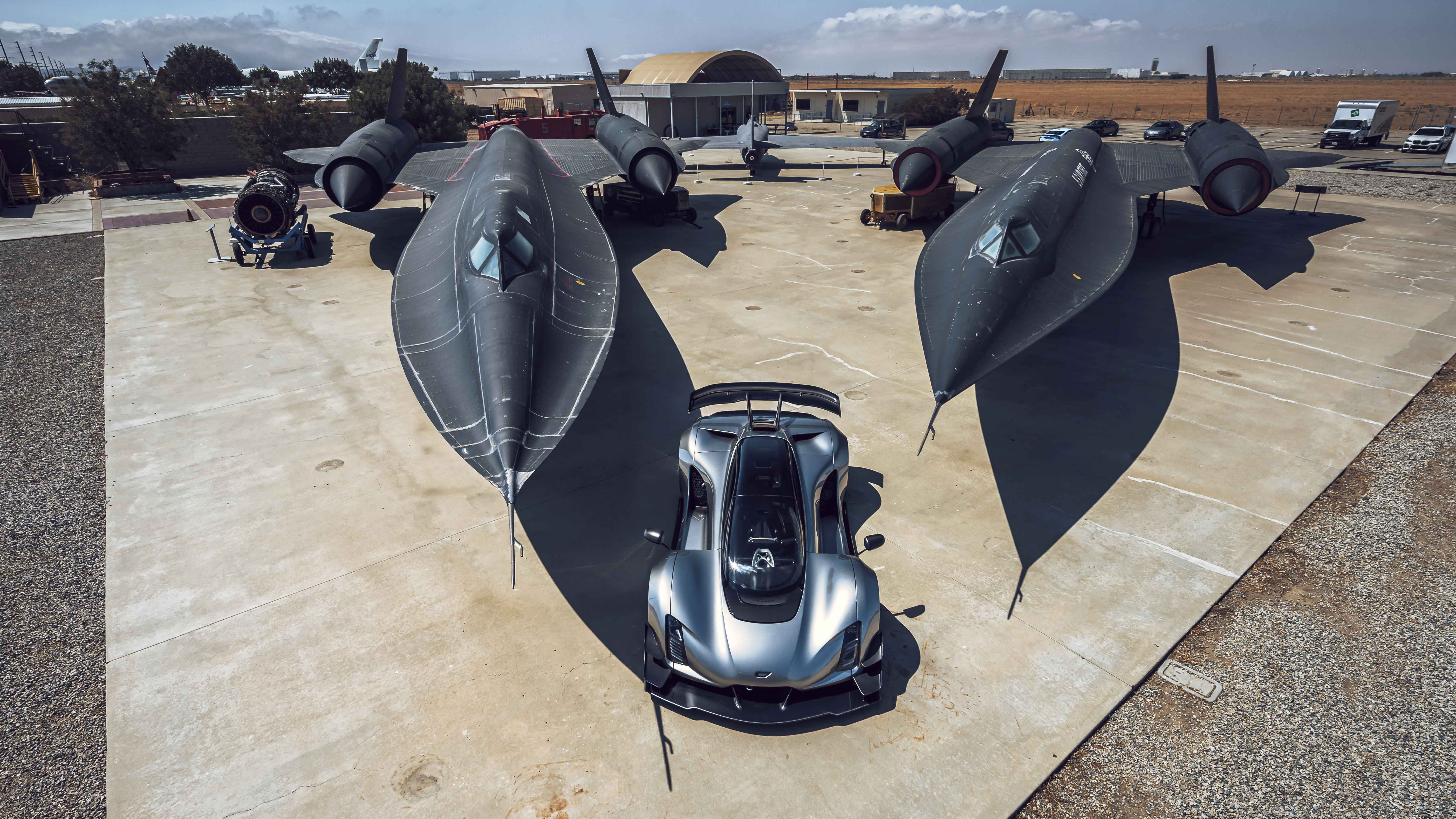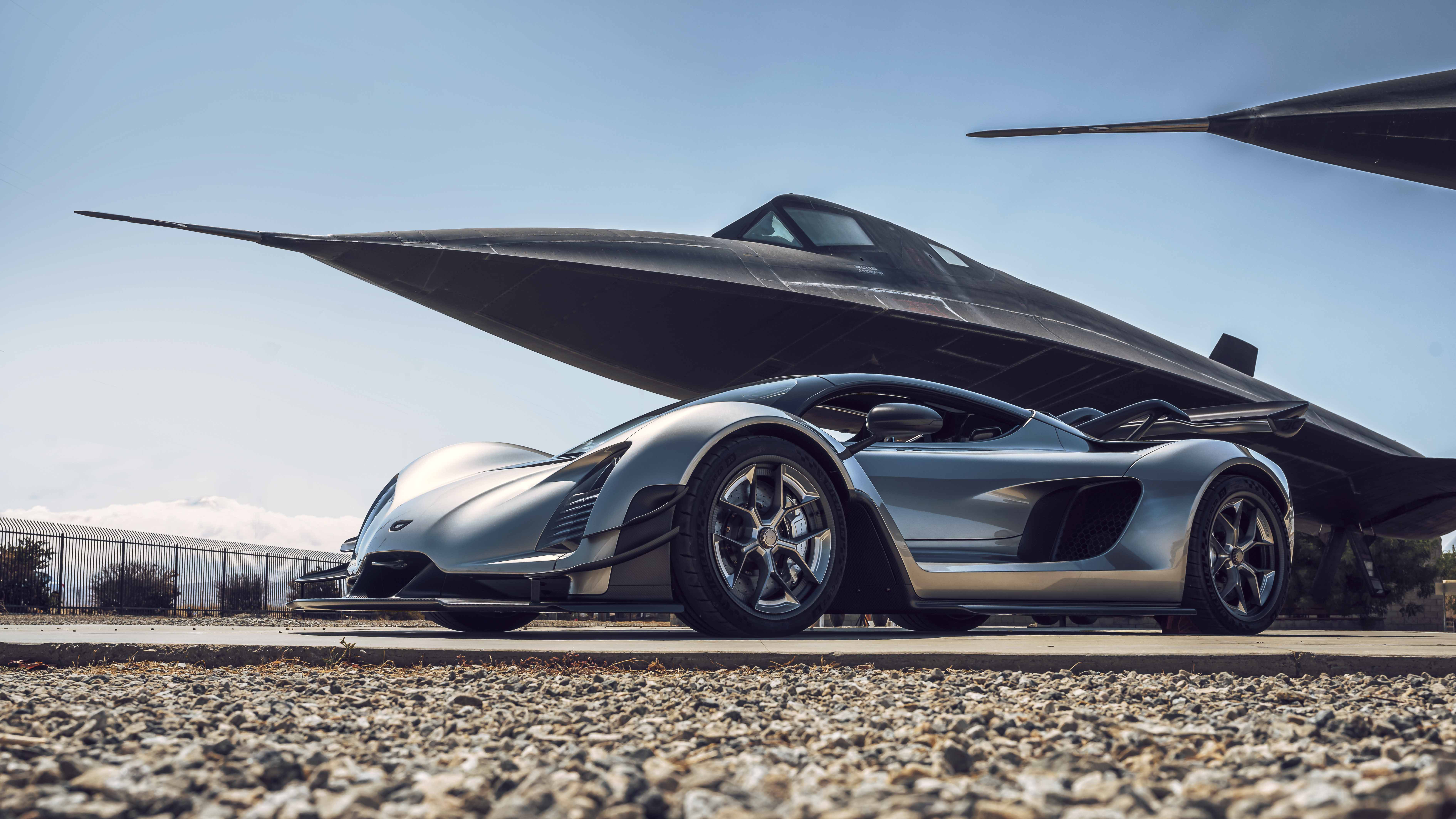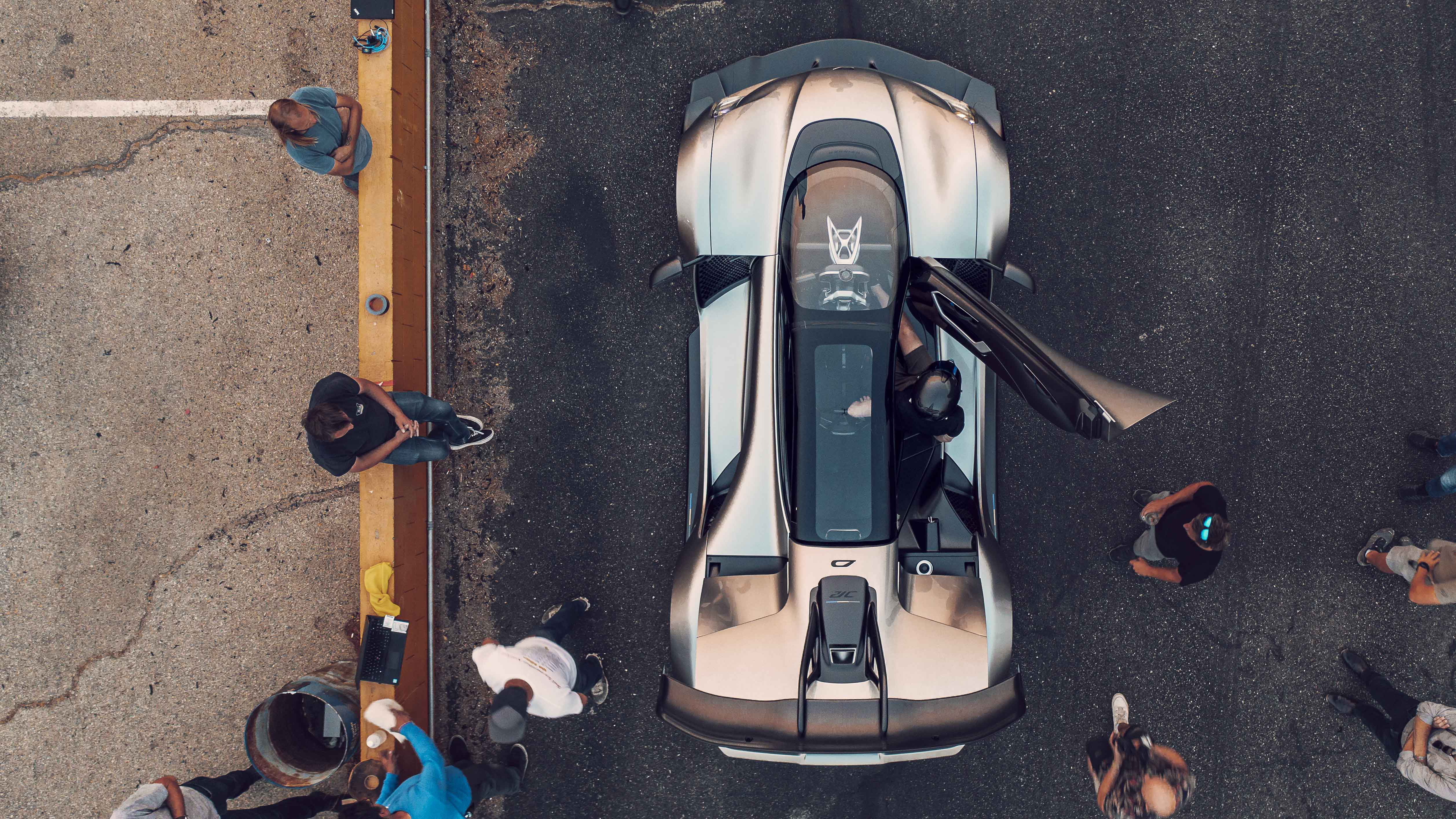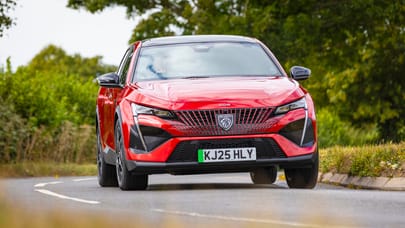
Czinger 21C driven: on the road in a 1,233bhp V8 hybrid supercar
A 3D printed hypercar with Laguna Seca lap record pedigree. We’re first to drive a very early prototype. Prepare for take-off
Want an idea of how abnormally rapid the Czinger 21C is?
I’ve just watched, hands on cheeks from the pitlane, as it ripped its own roof off down the straight at Willow Springs. A polycarbonate panel peeled back like a can of tuna and sent cartwheeling into the air... ta-da! The Czinger 21C Spider gets an early reveal. To be fair it did have one of our GoPros suckered to it (with Czinger’s permission) which at somewhere north of 150mph was clearly undoing the good work of that wing, and imparting some fairly serious lift. Cue a swift operation to reattach with black tack and gaffer tape. Good as new.
Apparently the beautifully finished bodywork, perched atop this prototype chassis and powertrain, was only fitted a few weeks ago to give potential customers something to coo over at Monterey Car Week... and had only been driven up to 20mph until now. Oh well, such are the trials and errors of working with an early car. Production of the 80 21Cs, costing $2m a pop, isn’t scheduled to start in earnest until 2023, but you don’t turn down the chance to be first to drive something this bonkers... even if it is a work in progress.
Rewind four hours and more fun and games. We’re on the road, about 20 minutes from Willow, surrounded by a forest of wind turbines whistling gently in the breeze. I’m behind the wheel, sweating like a sumo wrestler playing squash, and not because there’s no aircon yet... but because I’ve stalled on the wrong side of the road while turning left. A minivan has just crested the hill and approaches at speed. Fortunately, Kevin Czinger (the boss) and Luiz Oliveira (head of powertrain) leap to my rescue from the car in front and flag the traffic down as I restart the engine, bung a load of revs at it and haul myself out of harm’s way.
You see, the 21C currently has a straight cut racing-style dog box and a hair trigger hand clutch for getting off the line, which makes things tricky, especially when you’re turning hard left and the paddle has to swap hands as you’re feeding it out. On the flat, you can employ the two e-motors on the front axle to get you rolling forwards, and use that momentum to smooth the process, but I’d stopped on an upslope which negated the creep. Fortunately, it’s a temporary solution – a new Xtrac single-clutch auto arrives early next year, which promises to make low speed stuff not quite as life or death.
Photography: DW Burnett
Spool back further to the previous afternoon and we’re on Spunky Canyon Road – chosen for its topography, not comedic value – for perhaps the most bizarre moment of all. It’s my first taste of piloting the 21C: I’m drinking in the brilliance of the central driving position and the 360˚ visibility as the scenery rushes past the windows and the clouds slide by overhead. Propulsion, however, comes not from the V8 behind me, nor the motors out front, but by lifting my foot from the brake. Gravity is my fuel as we freewheel down a long hill to get some car-to-car photography in the bag. Why? Because Czinger’s new engine guru (former power unit engineer at Mercedes-AMG F1, a man who knows a thing or two about high-performance hybrids) Luiz Oliveira is on a plane back from his holidays in Hawaii and they don’t want to fire it up without his laptop close at hand. Fair enough. Fortunately, chapter one in the how-to-be-a-writer-for-TopGear-handbook is entitled Whatever It Takes.
Rewind a bit more, and our 21C odyssey started earlier that day on a high – at the Blackbird Airpark in Palmdale, California. We arrive to find the 21C not being upstaged despite being the meat in a supersonic stealth plane sandwich. On one side the SR-71 Blackbird, on the other its precursor the A-12 – still the fastest manned planes to ever fly and hands down the most advanced aircraft ever, relative to the tech available at their conception. We stand gawping for several minutes before photographer Dave – clearly a fanboy – starts spouting random, mind-blowing SR-71 facts. I learn that the entire fuselage is a fuel tank, and because engineers needed to account for superheating and expansion of the titanium skin at cruising speeds, it leaked fuel through the panel gaps on the runway. I also learn the A-12, this crazy slice of reconnaissance perfection, was developed in under two years by a crack team of 135 engineers led by Kelly Johnson, and the SR-71 took flight a little over two years after that. This is significant.
Kevin Czinger claims he took inspiration from the SR-71 when he was devising the 21C – not for the styling or powertrain – but for the skunkworks mentality that made it possible to build a spy plane capable of cruising at Mach 3.2 at 85,000 feet in such an incredibly tight time frame. He wants his Californian hypercar, like this Californian plane, to be a giant leap... a tech reset that challenges everything we know about how we build cars. Except, the Czinger 21C might have four wheels and a windscreen, but it isn’t really a car at all, it’s a demonstrator for what’s possible with digital design and 3D printing.
Any part of this car that can be 3D printed is: the suspension arms, the crash structures, the dashboard, the exhaust mufflers to name just a handful of the Ctrl+P components, all printed from Inconel, aluminium and titanium alloys. Peer into the engine bay and it’s more anatomy lesson than automotive tradition – sinewy, organic shapes looking like tendon and muscle bolted to simple off-the-shelf extrusions. The immediate benefits are obvious – putting material only where you need it reduces weight and builds strength – but it runs deeper than that. By 3D printing the gearbox casing, for example, you can integrate the heat exchangers into the internal structure, rather than hanging them off the side, saving space and improving efficiency.
And when you have complete flexibility in the size and shape of components you can print, there’s complete flexibility in how you design and build that car with none of the costs and baggage associated with traditional car factories. A modular, fully automated car manufacturing system made up of 10m x 10m cells that can be switched to build one model in the morning, and a different one in the afternoon. That’s where Czinger’s going, licensing that tech, that’s where the big bucks are. But as Kevin Czinger told me when I first met him two years ago: “If you’ve got the tools to build something totally off the hook, go for it.”
The gearbox bangs down the gears with all the subtlety of an Anthony Joshua uppercut
Well, he went for it. Driven by Kevin’s love of superbikes, and his insistence on a 1+1 seating layout, the proportions are extraordinary: it’s long and low from the side then insectile from the front, with its 2m width cradling a sliver of a cockpit. Naturally, a front axle full of electric motors, a driver, a passenger and a V8 engine all in a line brings certain quirks. The position of the driver, pushed right into the nose like a Seventies turbo-era F1 car, is one; the world’s longest dihedral doors are another; not to mention the massively wide side sills (home to the twin 2.6kWh batteries) that you have to sit on and swivel to post your legs in.
Top Gear
Newsletter
Thank you for subscribing to our newsletter. Look out for your regular round-up of news, reviews and offers in your inbox.
Get all the latest news, reviews and exclusives, direct to your inbox.
The bare numbers are just bananas. A claimed dry weight of 1,240kg, a combined 1,233bhp from a hybrid powertrain consisting of an in-house developed twin-turbo 2.9-litre V8 revving to 11,000rpm, courtesy of Kawasaki cylinder heads, and two e-motors on the front axle, one for each of the wheels. In this high drag configuration Czinger claims it makes 650kg of downforce at 100mph, 2,500kg at 200mph and has a top speed of around 253mph, while in low drag spec top speed is 281mph, 0–62mph takes 1.9 seconds and 0–186mph takes 8.5 seconds... for reference a Chiron Super Sport takes 12.1.
Here we go then. I’m giving myself a run up to pull out onto the road – a series of smooth curves and elevation changes we’ve picked out with generous turning circles at either end. The CEO, on the lookout for other cars, gives me the thumbs up. I release the brake, let it trickle forwards then ease out the clutch paddle with an unsympathetic side order of throttle. A stutter, but I catch it and we’re up and running and wow, instantly, it’s all about the central driving position. I’ve never driven a McLaren F1 or Speedtail, but believe the hype, it not only laser focuses you on the job of driving but makes placing yourself on the road an art form. Whereas once I was blind, now I can see.
The data’s flooding in. From the ride quality (surprisingly supple) to the gearbox (now as clinical as it was truculent at low speeds, smacking in upshifts so long as you’re on throttle, banging down the gears with all the subtlety of an Anthony Joshua uppercut), the throttle response (some initial lag despite the electric assistance, giving way to a dam burst of torque as the turbos spool) to the steering (light, quick, but loading up properly in the turns). There’s potential and promise here, but we’re not in its happy place. What we need, is somewhere to really throw the shackles off...
As I wait in the pits – strapped in, helmet on, a small army of mechanics milling around checking vitals – I catch the eye of one of the more senior engineers. He smiles, gives me a thumbs up followed by the unmistakable international sign – palms down pushing towards the floor – for breathe, stay calm, and if you crash this thing I’m going to personally strangle you. Message received, loud and clear. It’s around this time my mind wanders to the car’s recent achievement – this actual car – taking a two-second bite out of the McLaren Senna’s lap record at Laguna Seca in the hands of Joel Miller.
Today we’re at Willow Springs and there shall be no lap records. Joel’s here (it was him doing the shakedown when the roof ejected itself) but there simply isn’t time to set up the car and give him a proper crack at another scalp. Besides, there’s some British journalist hogging all the seat time. A sighter lap of Big Willow, one of the oldest tracks in the US, confirms it doesn’t take any prisoners – an endless double-apex right hander here, an off camber crest directly into a downhill right hander there, a mammoth straight braking into a 90˚ left... it’s not a layout to be taking liberties on when you’ve got well over 1,000 highly boosted horsepower at your disposal, no traction control and rudimentary ABS.
I feel my way in for half a lap, then start attacking a bit harder. Immediately the ragged edges are smoother, the gearbox works better, the steering gets more talkative and the aero starts to work, pinning you down in the faster sections. The manners might need refining, but the fundamentals are solid. The more confidence I find, the car matches and multiplies it. It’s up on its toes now, jinking and playing. The engine lights the afterburners on the straights, but prefers a lower gear and all the revs in the slower stuff (first gear runs all the way to 75mph). We’re too used to instant torque these days, this requires more flogging, but get it right and the results are predictably eye-popping. Out here, chasing lap times not traffic lights, is where the 21C was born to be and in a moment, none of the false starts and mechanical hiccups matter. It’s simply a privilege to be tearing up the track, chasing the embers of the day, in something as genetically advanced as this.
Early next year a heavily updated 21C V2.0 prototype will be built – that means a new gearbox, rebuilt engine, carbon tub and as many cracks ironed out as possible. It’s a mighty undertaking, but the idea it represents and the inspiration behind it sets it apart from the vapourware pack. There are flickers of genius here and a road map to production, which is why I leave with ears ringing, hands tingling and hope. Imagine what it’ll be like when it’s finished.
Trending this week
- Car Review
Hyundai Kona
- Long Term Review
Time's up with the Mini Countryman: here's the six-month verdict




